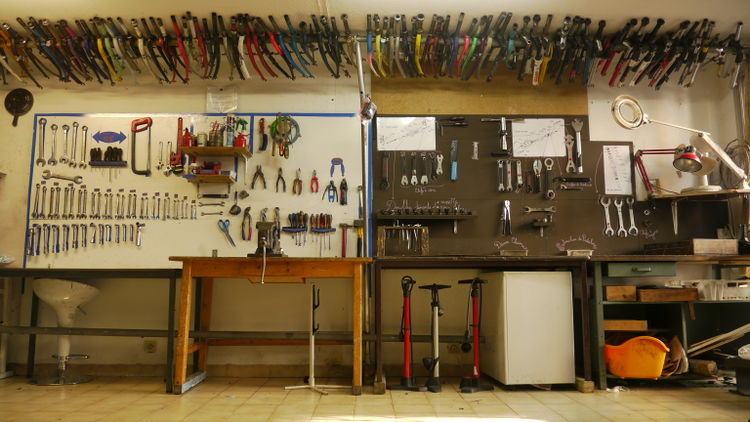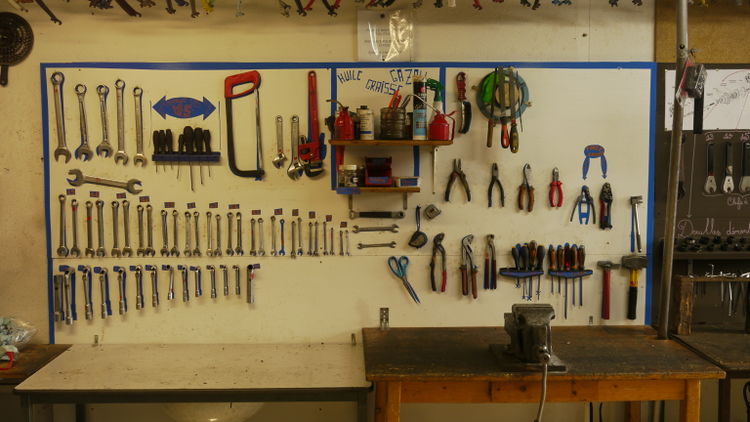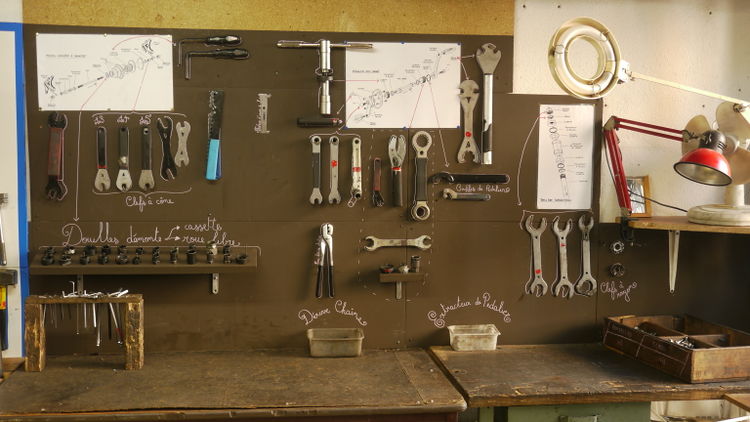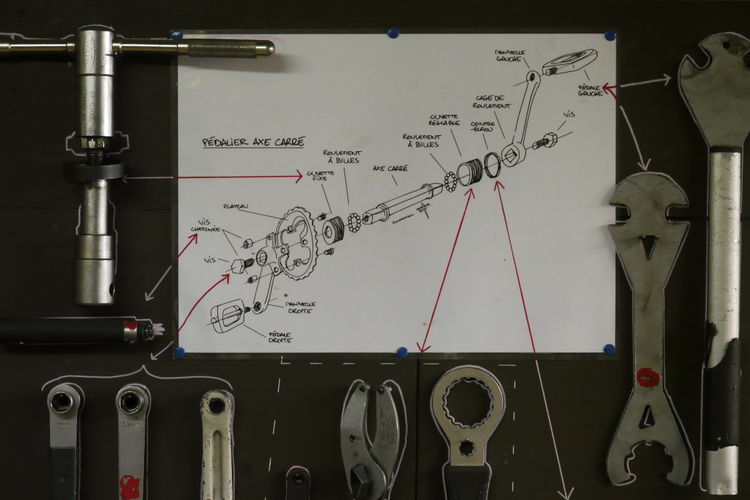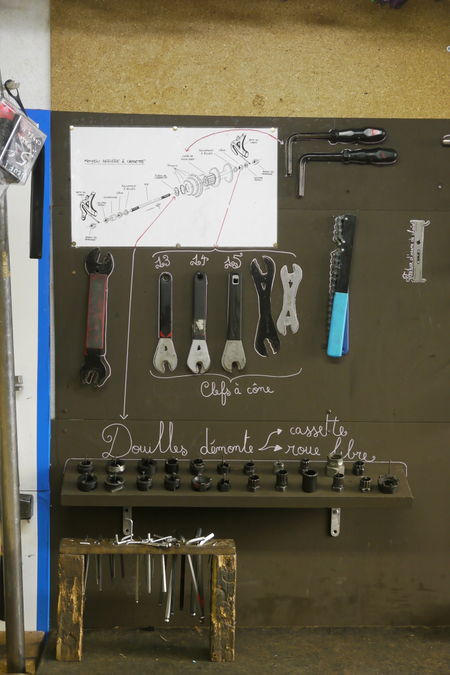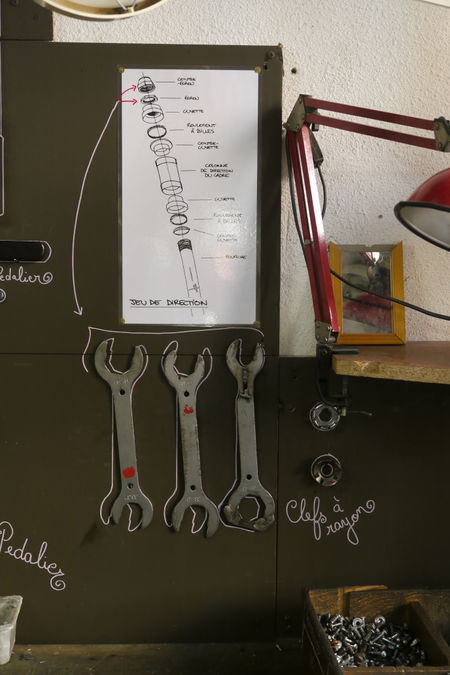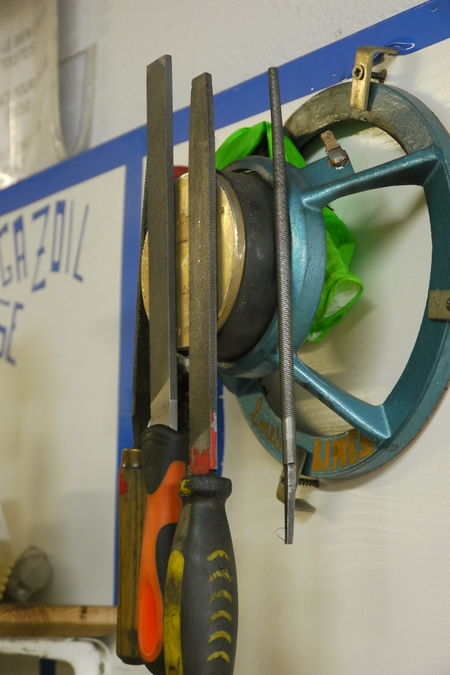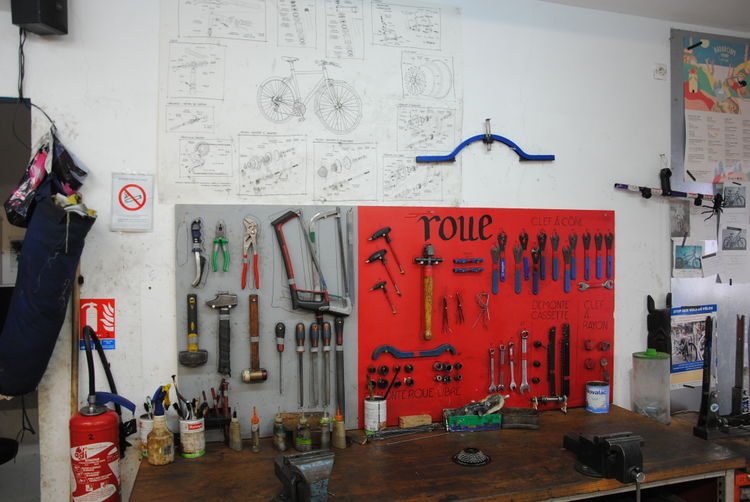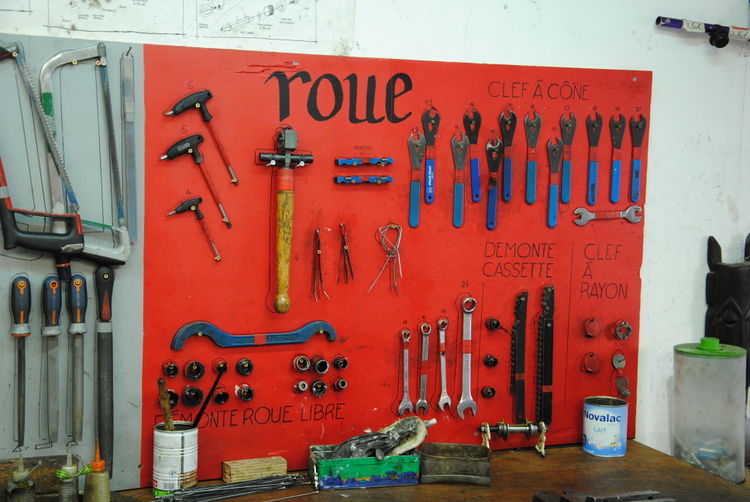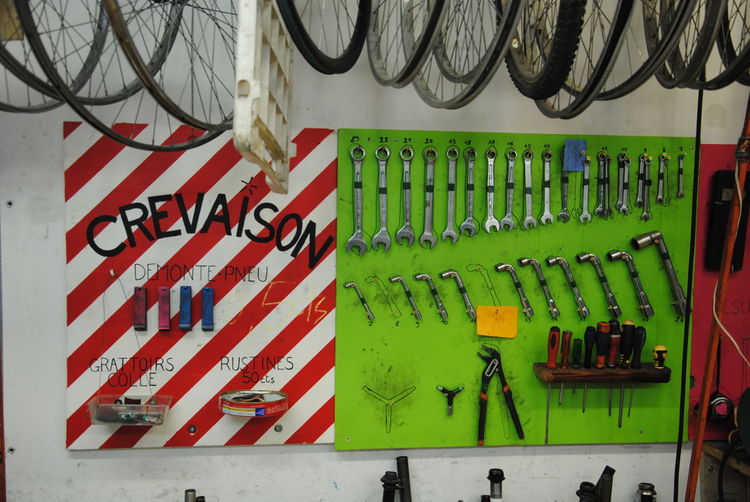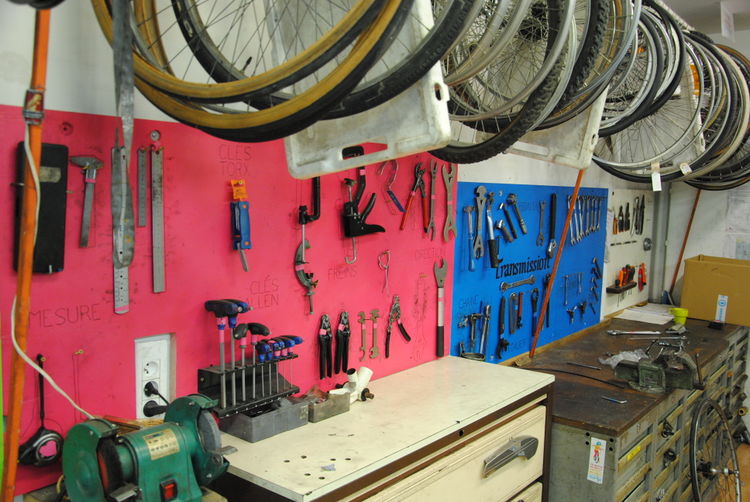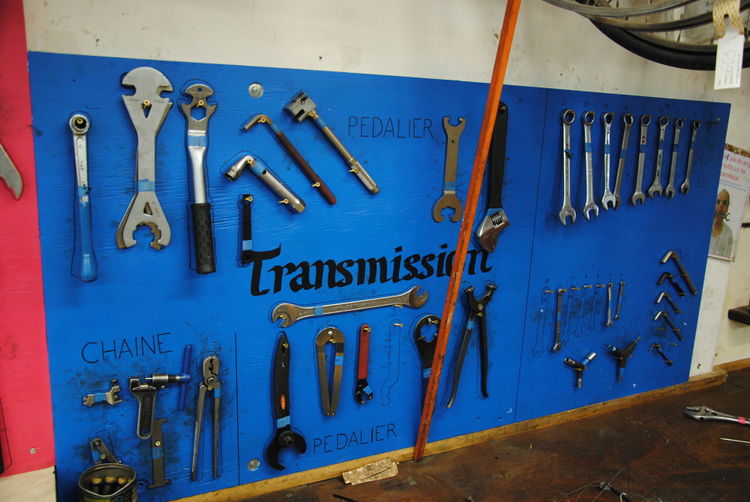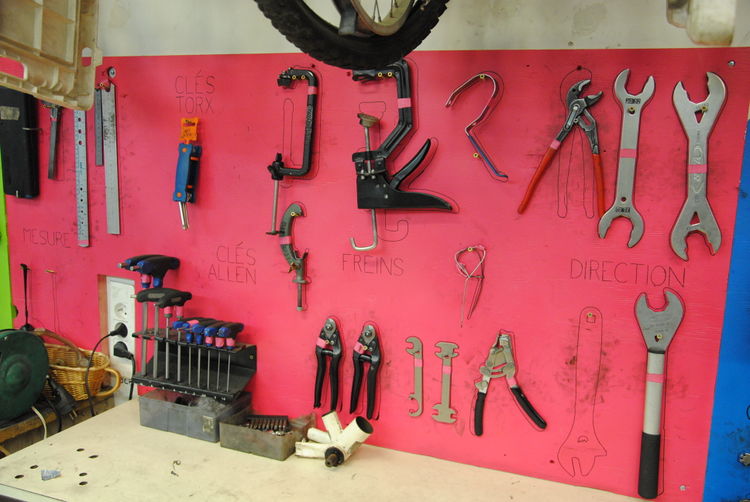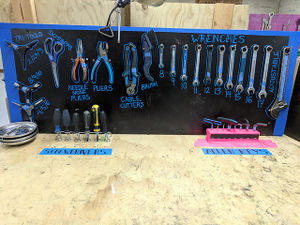Panneau d'outillage pédagogique : Différence entre versions
(→Supports visuels) |
m (correction du lien) |
||
| (5 révisions intermédiaires par 3 utilisateurs non affichées) | |||
| Ligne 22 : | Ligne 22 : | ||
| − | Pour le panneau des outils spécifiques, on a | + | Pour le panneau des outils spécifiques, on a utilisé de l''''affichage technique pour lier les outils aux pièces mécaniques correspondantes''' |
| Ligne 38 : | Ligne 38 : | ||
On aura bien sûr reconnu la patte de '''Monsieur Petit'''. | On aura bien sûr reconnu la patte de '''Monsieur Petit'''. | ||
| − | On a utilisé son dessin technique isométrique que nous avons modifié pour faciliter le tracer de | + | On a utilisé son dessin technique isométrique que nous avons modifié pour faciliter le tracer de flèches : |
<gallery> | <gallery> | ||
| Ligne 49 : | Ligne 49 : | ||
[[Fichier:Panneau d'outillage du Vieux biclou 04.JPG|450px|C'est le gros aimant qui nous sert à ternir les limes.]] | [[Fichier:Panneau d'outillage du Vieux biclou 04.JPG|450px|C'est le gros aimant qui nous sert à ternir les limes.]] | ||
| + | |||
| + | == Les panneaux du [[Collectif Vélos en Ville]] == | ||
| + | [[Fichier:Panneaux outils Collectif Vélos en Ville 1.JPG|750px|Panneaux outils Collectif Vélos en Ville 1]] | ||
| + | [[Fichier:Panneaux outils Collectif Vélos en Ville 2.JPG|750px|Panneaux outils Collectif Vélos en Ville 2]] | ||
| + | [[Fichier:Panneaux outils Collectif Vélos en Ville 3.JPG|750px|Panneaux outils Collectif Vélos en Ville 3]] | ||
| + | [[Fichier:Panneaux outils Collectif Vélos en Ville 4.JPG|750px|Panneaux outils Collectif Vélos en Ville 4]] | ||
| + | [[Fichier:Panneaux outils Collectif Vélos en Ville 5.JPG|750px|Panneaux outils Collectif Vélos en Ville 5]] | ||
| + | [[Fichier:Panneaux outils Collectif Vélos en Ville 6.JPG|750px|Panneaux outils Collectif Vélos en Ville 6]] | ||
| + | |||
| + | == Les Panneaux d'Amérique == | ||
| + | |||
| + | === Galerie Photo === | ||
| + | |||
| + | [https://www.flickr.com/photos/jbisker/sets/72157664886034257/ Galerie photo des panneaux] des ateliers du [http://www.bikecollectives.org/ Bike Collective Network]. Le nom de l'atelier d'où provient le panneau est inscrit en bas à gauche de chaque photo. | ||
| + | |||
| + | === Explications (en anglais) : avantages, enseignements, retours des utilisateur.ice.s === | ||
| + | |||
| + | Celui qui a créé cette galerie photo a également envoyé un mail d'explications sur la liste de discussion thethinktank@lists.bikecollectives.org : | ||
| + | |||
| + | "Pals! Thanks so much for your tool board photos and reflections. I have an update from us below, and then links to a photo gallery of everyone's submissions from the Think Tank and Facebook. | ||
| + | |||
| + | Update: we dramatically reduced the number of tools on our main tool boards to just the essentials, and collected the more bikey tools to a single mechanics board and a tool chest. Below is a photo of our new tool board layout. Charlie's Freewheels in Toronto was our closest model for inspiration: thank you Charlie's! | ||
| + | | ||
| + | [[Fichier:New York Mechanical Garden Bike Coop Toollboard.jpg|thumb|Panneau d'outillage de la New York Mechanical Garden Bike Coop ; créé par Josh Biker après consultation des ateliers de la Bike Collectives Network]] | ||
| + | |||
| + | The new layout has been HUGELY helpful for participants and volunteers. | ||
| + | |||
| + | People are less intimidated by the boards! The whole situation is more approachable. | ||
| + | * Things get put back more often and with less hassle. | ||
| + | * Fewer broken and missing tools. | ||
| + | * Better interface for volunteers to help out before participants try a repair that requires expertise or finesse. | ||
| + | * Easier to expand operations -- we can see adding a second set of tools to each board on the same pegs as the current ones, with minimal costs and no added confusion. | ||
| + | |||
| + | Also! Taking one cue from the shipping container bike repair station in Winnipeg and another from the short tool boards in Salt Lake City, we also rearranged the layout of our shop, and it kicks ass. | ||
| + | |||
| + | * We used to have a shop floor with tool board and benches on the perimeter and work space in the center. Chaos! | ||
| + | * NOW, we have the benches and tools in the center, and stands on the perimeter. SO SMOOTH! It's way, way easier and nicer to work. | ||
| + | * We also shortened the heights of the work benches so there's one tall, one medium, one small. | ||
| + | * AND, because we shortened the heights of the tool boards, you can see right over them -- so the space feels unified and coherent, not like a bunch of random siloed activities. | ||
| + | | ||
| + | Lessons we learned: | ||
| + | |||
| + | * Fewer tools on each board is better for everyone. Couple this with a master mechanics' board for success. | ||
| + | * Pegboard is the WORST. Plywood and nails 4EVA. | ||
| + | * Yes, mark the boards with tool names and sizes, BUT ALSO: mark the tools. Use an enamel paint marker and clear-coat it with nail polish. This way, new folks can learn the sizes of wrenches and the names of things when they're in hand, and can also easily put them back on the boards. | ||
| + | * In a space like ours, centrally located tools and work benches are better than peripheral ones, because they improve the flow of people through the space. | ||
| + | |||
| + | Future considerations: | ||
| + | |||
| + | * We're going to add offset brake wrenches to the boards, because they are so everyday-useful. | ||
| + | * We should have tried doing the outlines with chalk markers, not enamel markers, so that they're easy to erase and re-do. | ||
| + | * Our work benches are too bulky and big, especially since people do most of their work in the stand. Less work bench would be fine. By and large, people use them as tables, not work benches. What we really need are just places for folks to put the things they're working with. | ||
| + | |||
| + | I'd personally like to see the benches get decorated and personalized by volunteers, but that's a while away for us. | ||
| + | |||
| + | Photo gallery | ||
| + | |||
| + | Here's everyone's tool boards! I put them into a Flickr album. Each filename shows the co-op it came from. | ||
| + | |||
| + | |||
| + | xoxoxo | ||
| + | |||
| + | Josh | ||
| + | |||
| + | Josh Bisker | ||
| + | 914-500-9890 | ||
| + | New York Mechanical Gardens Bike Co-op | ||
| + | 596 Acres | ||
| + | Bindlestiff Family Cirkus | ||
| + | |||
| + | " | ||
| + | |||
| + | [[Catégorie:Pédagogie]] | ||
Version actuelle datée du 21 mars 2018 à 14:51
Amener un peu de pédagogie au panneau d'outillage, ça peut être bien, non?
Sommaire
Description
Apporter de la pédagogie au panneau d'outillage peut permettre:
- d'augmenter le niveau de connaissance technique des adhérents (nom des outils par exemple);
- reposer les référents pendant les ateliers puisque la mécanique devient beaucoup plus claire;
- d'augmenter la durée de vie des outils (en évitant à une clef à cône de 13 de servir à un serrage d'écrou de tube de selle par exemple).
Le panneau du Vieux biclou
On a commencé par séparer le panneau en deux :
- Outils généraux
- Outils spécifiques cycle
Attention pédagogie
Pour le panneau des outils spécifiques, on a utilisé de l'affichage technique pour lier les outils aux pièces mécaniques correspondantes
Supports visuels
On aura bien sûr reconnu la patte de Monsieur Petit. On a utilisé son dessin technique isométrique que nous avons modifié pour faciliter le tracer de flèches :
Le bonus
Les panneaux du Collectif Vélos en Ville
Les Panneaux d'Amérique
Galerie Photo
Galerie photo des panneaux des ateliers du Bike Collective Network. Le nom de l'atelier d'où provient le panneau est inscrit en bas à gauche de chaque photo.
Explications (en anglais) : avantages, enseignements, retours des utilisateur.ice.s
Celui qui a créé cette galerie photo a également envoyé un mail d'explications sur la liste de discussion thethinktank@lists.bikecollectives.org :
"Pals! Thanks so much for your tool board photos and reflections. I have an update from us below, and then links to a photo gallery of everyone's submissions from the Think Tank and Facebook.
Update: we dramatically reduced the number of tools on our main tool boards to just the essentials, and collected the more bikey tools to a single mechanics board and a tool chest. Below is a photo of our new tool board layout. Charlie's Freewheels in Toronto was our closest model for inspiration: thank you Charlie's!
The new layout has been HUGELY helpful for participants and volunteers.
People are less intimidated by the boards! The whole situation is more approachable.
- Things get put back more often and with less hassle.
- Fewer broken and missing tools.
- Better interface for volunteers to help out before participants try a repair that requires expertise or finesse.
- Easier to expand operations -- we can see adding a second set of tools to each board on the same pegs as the current ones, with minimal costs and no added confusion.
Also! Taking one cue from the shipping container bike repair station in Winnipeg and another from the short tool boards in Salt Lake City, we also rearranged the layout of our shop, and it kicks ass.
- We used to have a shop floor with tool board and benches on the perimeter and work space in the center. Chaos!
- NOW, we have the benches and tools in the center, and stands on the perimeter. SO SMOOTH! It's way, way easier and nicer to work.
- We also shortened the heights of the work benches so there's one tall, one medium, one small.
- AND, because we shortened the heights of the tool boards, you can see right over them -- so the space feels unified and coherent, not like a bunch of random siloed activities.
Lessons we learned:
- Fewer tools on each board is better for everyone. Couple this with a master mechanics' board for success.
- Pegboard is the WORST. Plywood and nails 4EVA.
- Yes, mark the boards with tool names and sizes, BUT ALSO: mark the tools. Use an enamel paint marker and clear-coat it with nail polish. This way, new folks can learn the sizes of wrenches and the names of things when they're in hand, and can also easily put them back on the boards.
- In a space like ours, centrally located tools and work benches are better than peripheral ones, because they improve the flow of people through the space.
Future considerations:
- We're going to add offset brake wrenches to the boards, because they are so everyday-useful.
- We should have tried doing the outlines with chalk markers, not enamel markers, so that they're easy to erase and re-do.
- Our work benches are too bulky and big, especially since people do most of their work in the stand. Less work bench would be fine. By and large, people use them as tables, not work benches. What we really need are just places for folks to put the things they're working with.
I'd personally like to see the benches get decorated and personalized by volunteers, but that's a while away for us.
Photo gallery
Here's everyone's tool boards! I put them into a Flickr album. Each filename shows the co-op it came from.
xoxoxo
Josh
Josh Bisker 914-500-9890 New York Mechanical Gardens Bike Co-op 596 Acres Bindlestiff Family Cirkus
"
